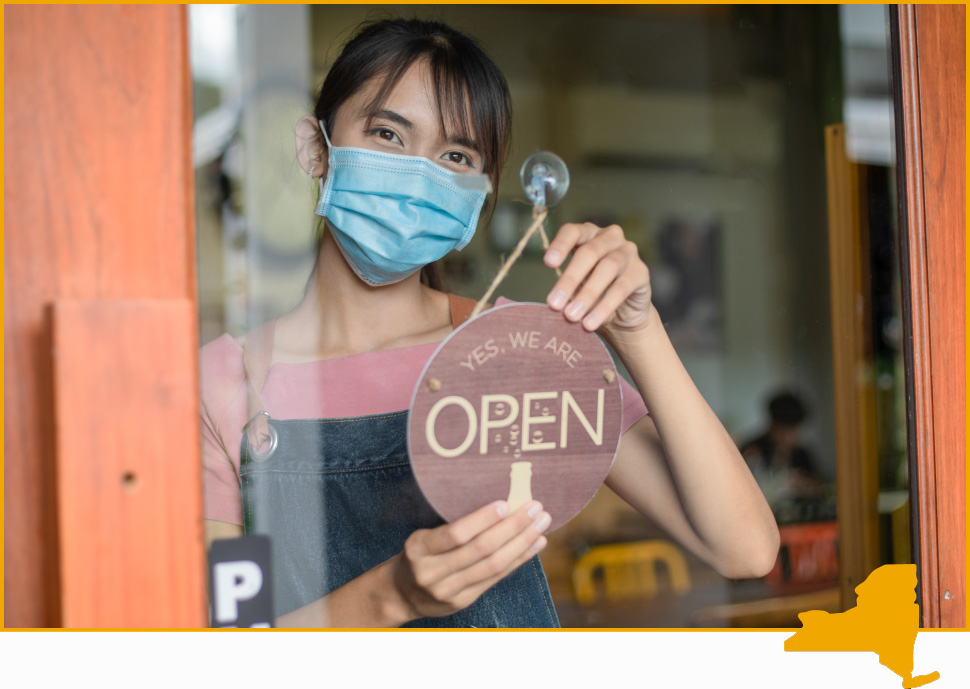
Funds are being used to address New York’s most urgent needs, including housing, government services, and deeply affected industries.

$12.75 billion transferred to the New York State General Fund
An additional $10.7 billion allocated to local governments*
*Including New York cities, counties, and non-entitlement units of government (NEUs).
How NYS dispersed SLFRF funding across eligible categories
The Restaurant Resiliency Program provided New York’s regional food banks with the funding to source meals from qualified restaurants. These meals were delivered to emergency feeding programs associated with the food banks’ network of providers, such as food pantries, soup kitchens, and shelters. Participating restaurants were encouraged to use New York ingredients to support New York’s farmers. Through State Fiscal Year (FY) 2023, the program supplied $24.8 million to provide over 1.1 million meals to people in need across the State, partnering with 269 restaurants.
Small businesses (fewer than 100 employees) and micro-businesses (fewer than 25 employees) throughout New York State have been awarded grant funds through the COVID-19 Pandemic Small Business Recovery Grant Program. This program has provided approximately $750 million in economic support to over 40,000 entities between FY 2022 and 2023. The program was created to provide flexible grant assistance to small businesses, micro-businesses, and for-profit independent arts and cultural organizations in the State of New York who have experienced economic hardship due to the COVID-19 pandemic.
The Office of Temporary and Disability Assistance created the Landlord Rental Assistance Program (LRAP) and the Emergency Rental Assistance Program (ERAP) to support New York residents unable to pay rent obligations they previously could afford prior to the pandemic. ERAP has provided significant economic relief to help low- and moderate-income households at risk of experiencing homelessness or housing instability by providing rental arrears, temporary rental assistance, and utility arrears assistance. LRAP has provided rental assistance for landlords whose tenants were unwilling to apply for the ERAP, including where the tenant has left the rental property. In FY 2023, SLFRF funds were used to extend assistance not provided under the traditional ERAP to more than 14,600 households. *
*SLFRF-related funding through this federal program represents a portion of the total Emergency Rental Assistance Program (ERAP). A more complete presentation of ERAP payments and application status is available on the OTDA website.
New York State identified workers whose duties have been substantially dedicated to public safety; SLFRF funds were used to cover costs associated with maintaining this workforce.
New York State provides a myriad of government services to almost 20 million New Yorkers through the work of its State agencies (including authorities, departments, divisions, offices, public benefit corporations, and other governmental entities). Service areas include mental health, transportation, support for children and families, parks & recreation, and many other core government services.
The Annual Recovery Plan Performance Reports show the use of SLFRF funds and how they are aligned with Federal guidance.
The Quarterly Expense Reports show the total allocation of SLFRF funds to specific categories of expenses, per quarter.
The data included on this page originates from New York State agencies and is reported to the U.S. Department of Treasury on a quarterly basis.
Please note: The NYS Division of the Budget does not have direct financial control or central oversight over State affiliated entities (e.g., localities, state and local public authorities) or non-New York State entities (e.g., businesses, private not-for-profit organizations, individuals)